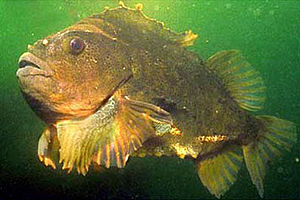Sea hare (fish)
| Sea hare | ||||||||||||
|---|---|---|---|---|---|---|---|---|---|---|---|---|

Sea hare ( Cyclopterus lumpus ) |
||||||||||||
| Systematics | ||||||||||||
|
||||||||||||
| Scientific name of the genus | ||||||||||||
| Cyclopterus | ||||||||||||
| Linnaeus , 1758 | ||||||||||||
| Scientific name of the species | ||||||||||||
| Cyclopterus lumpus | ||||||||||||
| Linnaeus, 1758 |
The sea hare ( Cyclopterus lumpus ), also rag , ragfish , rag fish , is a plump bottom fish from the sea hares family of the same name (Cyclopteridae) and thus belongs to the sub-order of the bull relatives (Cottales).
features
The sea hares are about 40 to 70 cm long and weigh 1.5 to 3 kg, the females are larger. They are dark gray-bluish to black, the females also appear a bit greenish. In some individuals, there are dark polka dots or black spots on the back and sides. Young fish are dull olive green to ocher yellow, with silver stripes and dots. Their physique is plump and plump, including the tail twice as long as it is high. The body is covered with bone teeth, four rows of thorns and three rows of bones run along the body and tail, sea hare have no scales. The mouth opening is right at the tip of the head, the teeth are relatively small, and the eyes and gill covers are relatively medium-sized. The short head, concave at the top and convex at the bottom, is slightly larger in the male than in the female.
The back fins are covered with thick skin tissue and form the so-called ridge. The front dorsal fin is 6- to 8-rayed, the rear and anal fin each 9- to 11-rayed. The caudal fin has a broad base and the tip is rectangular to slightly convex. The large, rounded pectoral fins are so wide in the approach that they almost reach the throat, in the male they are larger than in the female. Instead of pelvic fins, they have six pairs of fleshy bumps surrounded by an almost round skin fold, the diameter of which is the length of the head. This suction disk starts right behind the throat and is used to suck up the sea floor because they have no swim bladder . Thus they are adapted to life near the ground.
Occurrence
Sea hares are found on the stony seabeds of the coastal waters of the northern Atlantic in cooler water at depths of up to 850 meters. In the eastern Atlantic, their distribution area extends from the Barents Sea over the coasts of Iceland and Greenland to Spain and also includes the North Sea and the western Baltic Sea . In the western Atlantic they live from the coast of Nunavut over the Hudson Bay and James Bay , Labrador in Canada to New Jersey , rarely south to Chesapeake Bay on the Atlantic coast of the USA and near Bermuda .
Diet and predators
The sea hares feed on small fish, crustaceans , molluscs and rib jellyfish .
Because they are poor swimmers, they are a popular source of food for seals .
Reproduction
During the spawning season , the male's belly turns orange-red. To spawn, they swim in coastal waters that are dotted with algae. The females let about 140,000 eggs with a diameter of 2.2 to 2.6 mm sink, which are continuously rotated by the current on the stone bottom in spongy formations. While the females move back into deeper waters, the males guard the initially pink, later dull green or yellow spawn until the 4 to 7.5 mm long larvae hatch. During this time they do not eat any food, so that at the end of the guard they return emaciated and exhausted to deeper waters.
Economy

The roe , colored black and treated with brine , is marketed as "German caviar ", in Iceland as "Perles du Nord", and is therefore considered a caviar substitute for sturgeon roe . A female sea hare can produce up to 700 g of roe at spawning time.
The flesh of the female is loose and gelatinous, therefore not so sought after. On the other hand, the tasty meat of the male is firmer and pink. In the northern countries it is offered smoked or salted. Fresh sea hare meat tastes best breaded and fried. In Iceland it is considered a delicacy when dried.
Sea hares are bred in Norwegian fish farms and used as cleaner fish on salmon farms . They are supposed to control the infestation of salmon by the salmon louse , a copepod . Their use is intended to reduce the use of antibiotics in salmon farming. Furthermore, the sometimes explosive reproduction of salmon lice and the associated massive threat to wild salmon stocks and other marine fish should be contained.
Aquaristics
To keep sea hares in the aquarium, you need a tank with a volume of at least 2,500 liters. Because of this and because their natural habitat on the ground at depths of 50 m to 850 m, keeping them is reserved for zoos; they are by no means suitable animals for home aquariums.
literature
- John Davenport: Synopsis of the biological data on the lumpsucker Cyclopterus lumpus (Linnaeus, 1758). Rome 1985.
- Simon R. Thurston: Life in floating weed. London 1998.
Web links
- Sea hare (fish) on Fishbase.org (English)
- www.meerwasser-lexikon.de - Cyclopterus lumpus - Aquaristics and photo
- Description and picture on norwegenfisch.de ( Memento from October 28, 2007 in the Internet Archive )